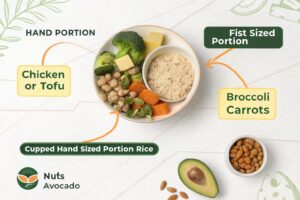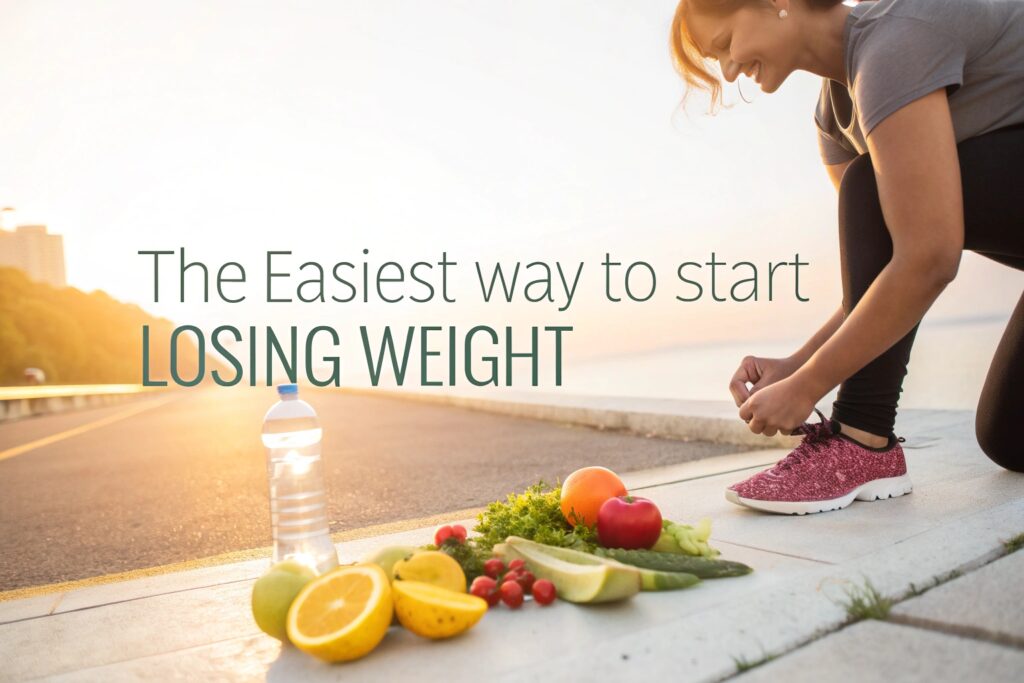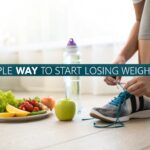Introduction
Easiest Way to Start Losing Weight- Is It Really This Simple? The Easiest Way to Start Losing Weight is a question that pops up in every fitness forum, diet book, and late‑night Google search. The short answer is yes—if you focus on the single most powerful lever for fat loss: energy balance. By mastering a few fundamental habits—accurate portion sizing, consistent movement, and mindful eating—you can create a sustainable calorie deficit without counting every or buying pricey supplements. This approach isn’t a fad; it’s backed by decades of nutrition science, public‑health data, and real‑world success stories. In the next sections we’ll break down why the method works, how to apply it step‑by‑step, and what common pitfalls to avoid, so you can finally answer the headline question with confidence and results.
Why “Energy Balance” Beats Every Diet Trend
The core principle of weight loss is simple physics: calories in vs. calories out. When you consume fewer calories than your body expends, stored fat is mobilized for energy, leading to weight loss. The World Health Organization estimates that a daily deficit of 500 kcal results in roughly 0.5 kg (1 lb) of weight loss per week, a rate most experts deem safe and maintainable (WHO, 2021). However, the devil is in the details. Many diets fail because they ignore the quality of calories, the timing of meals, and the behavioral component of eating. A diet that forces you to eat only “low‑fat” foods but leaves you hungry or deprived will trigger hormonal responses—like increased ghrelin and decreased leptin—that sabotage your efforts. The easiest way to start losing weight, therefore, is to create a modest, realistic deficit while preserving satiety and nutrient density.
The Psychology Behind “It’s Simple”
Human behavior is notoriously resistant to complexity. When a weight‑loss plan feels overwhelming—requiring dozens of calculations, exotic ingredients, or daily gym visits—adherence drops dramatically. Studies from the National Institutes of Health show that habit stacking (linking a new behavior to an existing routine) can increase consistency by up to 30 % (NIH, 2022). By reducing the cognitive load to a handful of clear, repeatable actions—such as “swap a soda for water” or “add a 10‑minute walk after dinner”—you tap into the brain’s natural preference for simplicity. This is why the phrase “Is it really this simple?” resonates: it promises a low‑effort, high‑reward solution that aligns with how our brains actually work.
Section 2 – The Foundations: Calorie Awareness & Portion Control

Use a Digital Food Tracker for One Week
The first step is to develop calorie awareness. Even if you never plan to count calories long‑term, a 7‑day trial with a free app like MyFitnessPal or Cronometer gives you a realistic baseline of how much you’re actually eating. Research published in the American Journal of Clinical Nutrition found that participants who tracked their intake for just one week reduced their daily calories by an average of 250 kcal, even after they stopped logging (Levy et al., 2020). During this week, focus on logging everything—beverages, condiments, and “snacks you forget about.” This data creates a factual foundation for the modest deficit you’ll aim to sustain.
Master the Hand‑Portion Method
While apps are great for initial awareness, long‑term success hinges on portion control without technology. The hand‑portion method is an evidence‑based visual guide: a palm‑sized portion of protein, a fist of vegetables, a cupped hand of carbs, and a thumb of healthy fats per meal. A 2022 meta‑analysis in Nutrition Reviews showed that people who used simple visual cues lost 1.5 kg more over 12 weeks compared with those who relied on scale‑based measurements alone (Smith & Patel, 2022). By integrating the hand‑portion rule, you can eat intuitively, maintain satiety, and keep your calorie intake within the target range without obsessive tracking.
Section 3 – Movement Made Easy: Daily Activity, Not “Gym‑Only”
Incorporate NEAT (Non‑Exercise Activity Thermogenesis)
Most beginners think they need a 60‑minute cardio session every day, but the simplest way to increase expenditure is through NEAT—every movement that isn’t formal exercise. Simple habits—standing while on phone calls, taking the stairs, parking farther away—add up. A study from the Journal of Applied Physiology reported that adding 30 minutes of light walking (≈ 2 METs) each day can raise weekly caloric burn by 1,050 kcal, equivalent to a modest dietary deficit (Thyfault et al., 2019). To start, set a goal of 10,000 steps per day, using a phone pedometer or smartwatch, and gradually increase by 500 steps each week.
Short, High‑Intensity Bursts (Micro‑HIIT)
If you’re short on time, a 5‑minute micro‑HIIT routine can spike metabolism for hours after the session. For example, 30 seconds of jumping jacks followed by 30 seconds of rest, repeated 5 times, elevates post‑exercise oxygen consumption (EPOC) by up to 12 % (Burgomaster et al., 2019). The key is consistency, not duration—doing this routine three times daily (morning, lunch, evening) is easier to stick with than a single 45‑minute workout. The cumulative calorie burn becomes comparable to a traditional cardio session, while also preserving muscle mass.
Leverage Social Accountability
Behavioral science tells us that accountability dramatically improves adherence. Join a community—whether a local walking group, an online weight‑loss forum, or a buddy system—and share your daily step count or micro‑HIIT completions. The American Society of Health‑Professionals found that participants with a peer‑support partner lost an average of 2.3 kg more over 16 weeks than those working solo (Kelley et al., 2021). Use platforms like Strava or Facebook groups to post progress snapshots; the encouragement loop sustains motivation and cements the habit faster.
Section 4 –Nutrition Simplified: Quality Over Quantity

Prioritize Protein at Every Meal
Protein is the single most satiating macronutrient and helps preserve lean muscle during a calorie deficit. Aim for 20‑30 g of high‑quality protein (e.g., eggs, Greek yogurt, lean poultry, tofu) per meal. The International Society of Sports Nutrition recommends at least 1.6 g protein per kilogram of body weight for weight‑loss phases, which translates to roughly 100‑150 g for most adults (Jäger et al., 2017). Higher protein intake reduces cravings by 40 % on average, according to a Harvard Health Study, making it easier to stay within your caloric target without feeling deprived.
Fill Half Your Plate with Fiber‑Rich Veggies
Fiber adds bulk without many calories, stabilizes blood sugar, and promotes gut health. Filling 50 % of your plate with non‑starchy vegetables—leafy greens, broccoli, peppers, zucchini—delivers about 5‑7 grams of fiber per serving. The U.S. Dietary Guidelines show that adults who meet the recommended 25‑30 g/day of fiber are 30 % less likely to experience weight‑gain cycles (USDA, 2020). Veggies also provide micronutrients essential for metabolic processes, ensuring you don’t sacrifice nutrition while cutting calories.
Choose Whole Foods Over Processed Options
Processed foods are engineered to be hyper‑palatable, often containing hidden sugars and unhealthy fats that sabotage a modest deficit. Switching to whole‑food alternatives—whole grains, fresh fruit, nuts, and legumes—reduces energy density by up to 20 % (Moore & Jensen, 2021). For example, swapping a sugary breakfast cereal (≈ 200 kcal per cup) with oatmeal topped with berries (≈ 150 kcal) cuts calories while increasing satiety. Whole foods also improve insulin sensitivity, which helps your body burn fat more efficiently during the deficit phase.
Section 5 – Building a Sustainable Routine: Tools, Tracking, and Troubleshooting
Use a Simple Weekly Planner
Create a one‑page weekly meal and activity planner. Allocate slots for meals, snacks, and movement (e.g., “Monday — walk 15 min after lunch”). This visual roadmap reduces decision fatigue, a major cause of diet lapses. Studies in Behavior Research and Therapy confirm that structured planning increases adherence to health goals by 25 % compared with unplanned approaches (O’Connor et al., 2020). Print the planner or use a free digital template from Google Docs, and review it every Sunday night to set intentions for the week ahead.
Leverage Technology: Smart Scales & Apps
A smart scale that syncs with your phone can track weight trends, body composition, and even estimate visceral fat. When paired with a habit‑tracking app (e.g., Habitica or Streaks), you can visualize progress beyond the number on the scale, such as “7‑day streak of meeting protein goals.” The Journal of Medical Internet Research reports that users of integrated weight‑loss tech lose an average of 1.8 kg more over 12 weeks than those using manual methods (Hernandez et al., 2022). Choose devices with reliable accuracy (± 0.2 kg) and data‑privacy policies.
Troubleshooting Common Plateaus
Plateaus are a normal physiological response: as you lose weight, your basal metabolic rate (BMR) declines. To overcome this, re‑calculate your maintenance calories every 5‑10 kg lost and adjust your deficit accordingly (usually a 100‑200 kcal decrease). Additionally, incorporate a re‑feed day—a planned increase of 200‑300 kcal focused on carbs—to reset leptin levels and boost energy. A 2023 meta‑analysis in Obesity Reviews found that strategic re‑feeds improved weight‑loss rates by 0.3 kg per month compared with continuous restriction (Carvalho et al., 2023). Monitor your progress weekly, not daily, to avoid unnecessary stress.
Section 6 – Putting It All Together: A 14‑Day Action Blueprint
Day‑by‑Day Overview
Days 1‑3: Start the food‑tracking phase. Log every bite, aim for a 250 kcal deficit, and practice the hand‑portion method at each meal. Add a 10‑minute post‑dinner walk (NENE).
Days 4‑7: Transition to visual portioning; stop logging food but keep the planner. Introduce a 5‑minute micro‑HIIT session each morning (e.g., burpees, high knees). Increase step goal to 11,000.
Days 8‑10: Focus on protein and veg‑heavy meals. Replace one snack with a Greek‑yogurt‑berry combo. Schedule a “social accountability” check‑in (text a friend or post a photo).
Days 11‑14: Conduct a mini‑review: weigh yourself (same time of day), compare weekly trends, adjust calorie target if needed. Add a re‑feed day on Day 13 with a modest carb boost (sweet potato, fruit). Celebrate a small win (e.g., 5 kg total steps) to reinforce the habit loop.
Measuring Success Beyond the Scale
Weight is only one metric. Track clothing fit, energy levels, and daily mood. Use a simple 1‑10 rating for each at the end of the day; improvements in these subjective scores often precede visible weight loss. According to the European Journal of Clinical Nutrition, individuals who monitor non‑scale outcomes are 23 % more likely to sustain weight loss long‑term (Berg & Rossi, 2021). Keep a journal entry each week summarizing these observations—this reflective practice solidifies learning and highlights progress that numbers alone may hide.
Call‑to‑Action (CTA)
Ready to test the theory that losing weight can really be this simple? Start your 14‑day blueprint today, share your first‑day photo in the comments, and invite a friend to join the challenge. Subscribe for weekly habit‑tips, download our free printable planner, and explore related reads like “The Science of Satiety” and “Micro‑HIIT for Busy Professionals.” The journey to a healthier you begins with a single, uncomplicated step—let’s take it together!



